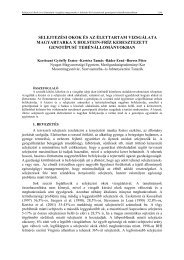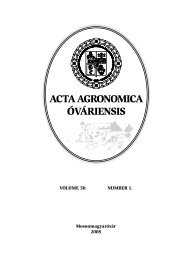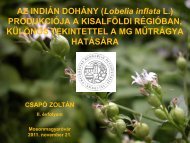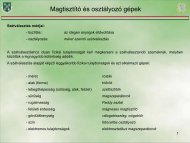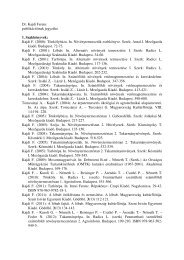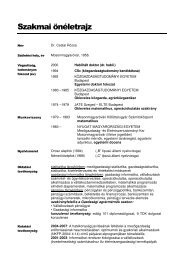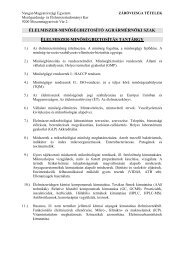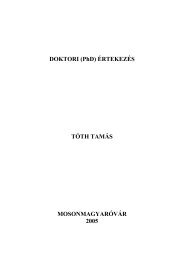teljes anyag - Nyugat-Magyarországi Egyetem Mezőgazdaság
teljes anyag - Nyugat-Magyarországi Egyetem Mezőgazdaság
teljes anyag - Nyugat-Magyarországi Egyetem Mezőgazdaság
You also want an ePaper? Increase the reach of your titles
YUMPU automatically turns print PDFs into web optimized ePapers that Google loves.
10E. Virág – Z. Molnár:INTRODUCTIONThe application of medicinal plants has become into prominence in last decades andexpectedly will widen on. The active compounds of several medicines and specifics withcurativ effect are provided by natural, synthetic and semisynthetic plant materials. Theincreased demand of remedies made from medicinal plants has entailed the expansion ofvolume of cultivation of medicinal plants though paralell with it the quality-insurance ofproduced plant materials has become very important, too. The quality and active contentof field-grown plant products depend on environmental factors, applied cultivation technologyand suitable primary-processing performed by producer in large scale. Elementalexpectation that industrial production of medicinal plant products need to be continuousand consistent (Petri2006).Nowadays permanent basic commodity supply is covered by in vitro micropropagation. Bythe help of this method sterile, homogeneous and quantity of plant material can be producedwithout reference to seasons and climate, correspondent agent-content is guaranteed.The purple coneflower is a wide-applied medicinal plant, it can be used by treatmentsof several diseases and health care, it’s colorful application possibility suits the present’srequirements (Csuporr2007).The object of this study is to establish wich section of plant and wich cytokinin concentrationis the most suitable to obtain intact plant by examination of plant regeneration inducedfrom shoot tip, leaf section and the base of leaf stick with different cytokinin concentrationsas well as characteristics of the micropropagation of Echinacea can be determined namelysuch as the effect of the surface sterilization, the mass of plant material producated duringunit of time and the numbers of shoots, leaves and roots produced by regenerated plants.Considering the specificities of the micropropagation of purple coneflower a method canbe elaborate wich can provide the necessary basic material in required quality and quantityfor manufacturing of Echinacea products. The improvement of quality and reliability ofmedicinal plant products can result in further increase of the use of natural materials.The characterization of purple coneflower (Echinacea purpurea L.)The genus Echinacea belongs to the family of Asteraceae and to the order of Asterales.The genus Echinacea is represented by 11 species wich are native in the USA and in centralCanada. Nowadays therapeutic importance of three species is known, these are Echinaceapurpurea L., Echinacea angustifolia L. and Echinacea pallida L., Echinacea purpurea L.is the most widely cultivated medicinal species of the genus.Purple coneflower is 80–150 cm tall. It’s roots are composed of filament-like side-roots.The coneflower’s stalk is cylindrical with antocyanic spots. It’s leaves are dark-green,shaggy and broad-spear. The stock leaves are 25–35 cm long, 7–12 cm wide, the stalkleaves are smaller and longish. The flower is cone-shaped, it blooms from Juny to September.The crop of Echinacea is brown-grey, cornered, the mass of thousand seeds is3.8–4.5 g (Bernáth2000).




